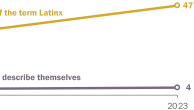I. Overview
When census takers, pollsters or bureaucrats with application forms ask people to identify their race, most have no problem checking a box that corresponds to one of the five, standard, government-defined racial categories. In the 2000 Census, for example, 90 percent of the U.S. population was counted as either white, black, Asian, American Indian or Pacific Islander. Hispanics are the exception. While a little more than half picked one of the standard categories, some 15 million, 42 percent of the Hispanic population marked “some other race.” Census 2000 and much other evidence suggests that Hispanics take distinctive views of race, and because their numbers are large and growing fast, these views are likely to change the way the nation manages the fundamental social divide that has characterized American society for 400 years.
According to federal policy and accepted social science, Hispanics do not constitute a separate race and can in fact be of any race. The 2000 Census asked respondents first to mark off whether they were “Spanish/Hispanic/Latino” and then in a separate question to specify their race. Among those who identified themselves as Hispanics, nearly half (48 percent) were counted as white. Blacks made up two percent. The American Indian, Asian, and Pacific Islander categories each accounted for small fractions. Surprisingly, given the large number of Latinos whose parentage includes combinations of white, African and indigenous ancestries, only six percent described themselves as being of two or more races. The only racial identifier, other than white, that captured a major share of the Latino population (42 percent) was the non-identifier, “some other race” (SOR). That is a sizeable category of people, outnumbering the total U.S. population of Asians and American-Indians combined.
“Some other race” is not exactly a political slogan or rallying cry. Nor is it a term anyone ordinarily would use in conversation or to describe themselves. So, who are the some-other-race Hispanics? And, what are they trying to tell us with their choice of this label?
In order to explore these questions the Pew Hispanic Center examined microdata from the 2000 Census as well as information from surveys and focus groups conducted by the Center. The Census numbers show that Latinos who call themselves white and those who say they are some other race have distinctly different characteristics, and survey data show they have different attitudes and opinions on a variety of subjects. Consistently across a broad range of variables, Hispanics who identified themselves as white have higher levels of education and income and greater degrees of civic enfranchisement than those who pick the some other race category. The findings of this report suggest that Hispanics see race as a measure of belonging, and whiteness as a measure of inclusion, or of perceived inclusion.
Given immigration’s important role in shaping the Hispanic population, nativity—whether a person was born in the United States or abroad—is a key characteristic. More foreign-born Latinos say they are of some other race (46 percent) than native-born (40 percent). Cuban-born immigrants are the exception. More importantly, whiteness is clearly associated with distance from the immigrant experience. Thus, the U.S.-born children of immigrants are more likely to declare themselves white than their foreign-born parents, and the share of whiteness is higher still among the grandchildren of immigrants. In addition, U.S. citizenship is associated with racial identification. Among immigrants from the same country, those who have become U.S. citizens identify themselves as white more often than those who are not U.S. citizens. It seems unlikely that the ability and willingness to become a U.S. citizen are some how linked to skin color. Thus, it may be that developing deeper civic bonds here can help an immigrant feel white.
The full extent to which race is a measure of belonging for Latinos becomes apparent in examining the native born alone. Immigration status and language do not play a direct role in determining economic or social outcomes for Hispanics born in this country, and their conceptions of race are primarily home grown. Among U.S.-born Latinos whiteness is clearly and consistently associated with higher social status, higher levels of civic participation and a stronger sense of acceptance.
- The share of native-born Latinos without a high school diploma is higher for those who say they are some other race (35 percent) than for those who call themselves white (30 percent).
- Unemployment runs two points higher among native-born Hispanic males who declare themselves some other race compared to those who say they are white and poverty rates are four point higher among adults.
- The share of native-born Latino men earning more than $35,000 a year is a third higher for those who say they are white compared to the some other race group (24.7 percent vs. 18.5 percent).
- Among all Hispanics, those who say they are some other race tend to be younger (median age 24) than those who say they are white (median age 27).
- More of those native-born Hispanics who say they are white (85 percent) are registered voters than those who say they are of some other race (67 percent).
- When asked whether they consider themselves Republicans, Democrats, Independents or something else, more native-born Latinos who say they are white (22 percent) pick Republican compared to those who say they are some other race (13 percent). The same pattern prevailed among the foreign-born.
- When asked to choose between the terms “American” versus “Hispanic or Latino” versus a national origin identifier such as “Mexican,” far more native-born Latinos who say they are white (55 percent) pick “American” compared to those who say they are some other race (36 percent).
- About a quarter of native-born Latinos who say they are white complain that discrimination is a major problem for Latinos in the United States compared to a third of those who say they are some other race.
These findings suggest that Latinos’ choice to identify as white or not does not exclusively reflect permanent markers such as skin color or hair texture but that race is also related to characteristics that can change such as economic status and perceptions of civic enfranchisement. Also, social context and the nature of race relations in a given place also appear to play a role. Hispanics of Mexican origin, who comprise about two-thirds of the total Hispanic population, are almost evenly divided between those who identify as white and those who pick some other race. However, in Texas many more native-born Latinos of Mexican descent say they are white (63 percent) compared to those who live outside of Texas (45 percent). Again, it seems unlikely that skin color is the determining factor. Instead, one can suppose that the unique and complex history of race relations in Texas is a major influence. This is the only state where a large Latino population was caught up both in Southern-style racial segregation and then the civil rights struggle to undo it.
Understanding Latinos’ views of their racial identities involves much more than defining a series of demographic sub-categories. Rather it helps illuminate the ways that race is being lived in the United States today. In the commonplace view, Latinos are an additional “group” that has been added to the American mix of white, black, Asian etc. And, in particular Latinos are categorized as a minority group that is significantly different from the white majority due to factors including a history of discrimination and persistently lower educational outcomes and incomes on average. The temptation is to racialize this population, to make it fit in the traditional American social paradigm which assigns people to race or at least race-like categories. But, the growing Hispanic population may compel a reassessment of the common view of a racial or ethnic group as a readily identifiable category of people who share a common fate and a common identity.
Categorizing Hispanics as a minority group, becomes much more difficult once you realize this population is almost evenly divided between those who identify with the white majority and those that have trouble seeing themselves in any of the standard racial categories. It is not that some are more Hispanic or Latino than the others because they all have taken on that mantle. Nor are they saying that race does not matter to them. Rather, the message seems to be that Latinos in the United States experience race differently. For them, it is not something that pertains exclusively to skin color, let alone to history and heritage.
For Latinos the concept of race appears to extend beyond biology, ancestral origins or a history of grievance in this country. The differences in characteristics and attitudes between those Hispanics who call themselves white and those who identify as some other race, suggests they experience racial identity as a measure of belonging: Feeling white seems to be a reflection of success and a sense of inclusion. The fact that changeable characteristics such as income help determine racial identification among Latinos, versus permanent markers such as skin color, does not necessarily mean that the color lines in American society are fading. On the contrary, these findings show that color has a broader meaning. The Latino experience demonstrates that whiteness remains an important measure of belonging, stature and acceptance. And, Hispanic views of race also show that half of this ever larger segment of the U.S. population is feeling left out.




